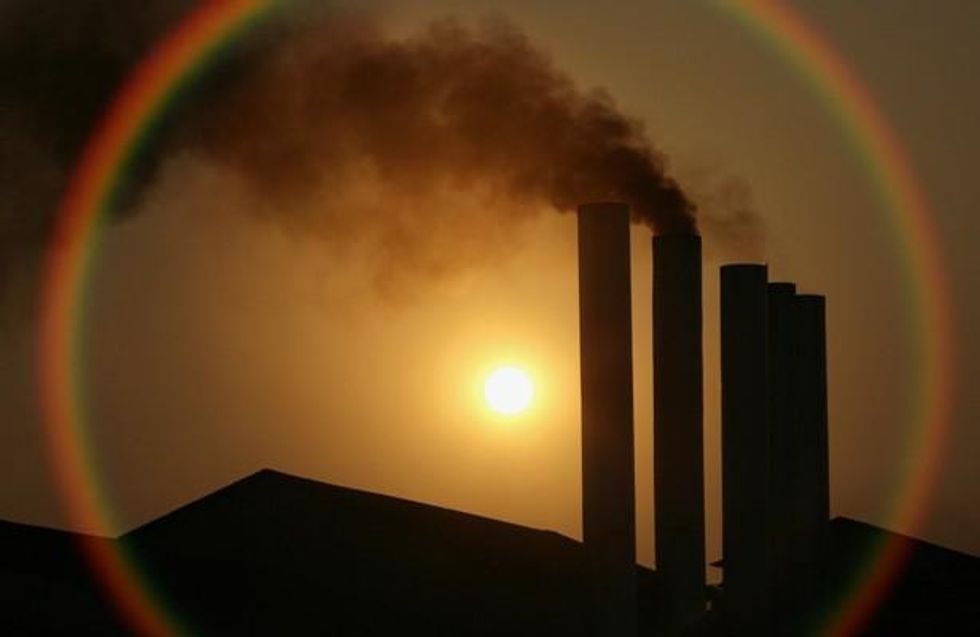The World Bank's latest report on climate change, "Turn Down the Heat," warns that the planet is on track for a four-degree Celsius temperature rise by 2100. Like many scientists, the bank fears that such an increase would be incompatible with civilization as we know it. At the very least, rapid global warming--and the storms, droughts and other extreme weather it would unleash--would render the bank's mission of alleviating poverty and fostering sustainable development impossible."This report is a stark reminder that climate change affects everything," World Bank President Jim Yong Kim writes in the forward to the report, which was authored by the Potsdam Institute for Climate Impact Research. "The solutions lie in ensuring all our work, all our thinking, is designed with the threat of a 4degC degree world in mind. The World Bank Group will step up to the challenge."
So far, so good. But how exactly will the World Bank "step up?" The answer, shockingly, is nowhere to be found in this report, and a review of the Bank's history on climate issues raises many red flags.
In 1992, at the Rio Earth Summit, when the scientific community warned that a climate crisis was imminent, the World Bank was charged with the task of marshalling the funds to address the emergency. But instead, over the next two decades, the bank invested roughly $48.8 billion not in clean energy, but in dirty fossil fuel projects in the developing world. Over the same time period, the Global Environmental Facility, housed at the bank, invested only $3.5 billion in climate change mitigation projects.
In 2005, researchers at the Institute for Policy Studies calculated that from 1992 to 2004, the World Bank had financed fossil fuel projects around the world that would release the equivalent of almost two year's worth of global greenhouse gas emissions over their lifetimes. Our research found that virtually none of this financing would meet the energy needs of the planet's poorest 2 billion people, nearly all of whom lived without access to electricity. Instead, the projects would power export-oriented heavy industry and urban areas and bolster the bank accounts of wealthy corporations like Exxon and Halliburton.
The World Bank responded to our report by challenging our methodology. We challenged its in return and demonstrated that its analysis was deeply flawed. The bank counted only the so-called "point source" emissions from power plants they financed, ignoring the full life-cycle carbon accounting that is standard procedure in most analyses. Pressured to conduct its own review, the Bank issued a 2004 report that showed that the global poor were actually harmed by the bank's fossil fuel investments, not helped. That 2004 report further urged the bank to stop financing coal immediately, get out of oil by 2008 and rapidly ramp up its investments in renewable energy sources.
The bank's board of directors voted to ignore these recommendations, with the exception of setting modest targets for renewable energy lending. Today, the bank's vice president for sustainable development, Rachel Kyte, claims that 44 percent of the bank's energy lending portfolio is devoted to renewable energy, up from 22 percent in 2007. But these figures are misleading: nearly half of this "renewable energy" is in fact large-scale dams, which themselves often carry enormous environmental and social costs.
But this raises the question: What about the remaining 56 percent of World Bank energy lending, most of it still devoted to fossil fuels? Is this what the bank calls "stepping up to the challenge" of climate change?
Under pressure from a wide array of actors, the World Bank is releasing a methodology for calculating the impact of its energy, transport and forestry lending at the Doha Climate Change Conference this week. While this step is long overdue, if the past is any guide, the bank will continue the highly lucrative and dubious trade in carbon credits--despite the fact that the EU Emissions Trading Scheme is in a shambles, with Italy's environment minister declaring that it should be scrapped. They will continue to act as an "honest broker" in the trade of carbon offsets (including those that create perverse incentives for polluters to pollute more). They will perhaps begin to calculate the enormous carbon "debits" they are helping to accrue in the earth's atmosphere, but they surely won't entertain any sort of cost to investors for those debits.
At UN climate talks now underway in Doha, delegates are negotiating the outlines of a Green Climate Fund (GCF), intended to help poor nations shift to clean energy sources and improve their resilience to climate impacts. Should the funding ever materialize, the GCF could be far greater than anything the World Bank has ever managed; over $100 billion per year by 2020 was pledged by industrialized nations for climate change adaptation and mitigation funds.
Daniel Kammen, the former World Bank renewable energy czar and now a distinguished professor at UC Berkeley, says he is not yet willing to endorse the World Bank as the chair of the GCF. To play that key role, Kammen says, "The World Bank Group needs to embrace 'rigor without mortis': develop and utilize a clear and transparent carbon accounting methodology, apply it to all projects and remain a thought leader as environmental accounting needs to extend to other issues needing metrics, [such as] particulate emissions, water pollution, biodiversity and community sustainability."
In the meantime, as writer Bill McKibben explains in his "Do the Math Tour," and as the authors of the International Energy Agency World Energy Outlook report make clear, if we are to stay below a 2C degree rise in temperatures, at least two-thirds of the proven fossil fuel reserves must stay in the ground.
So here is some unsolicited advice to the World Bank in how to "step up to the challenge" of climate change: First, do no harm. Show the world that you fully understand the implications of your research, stop wasting time and money on carbon offsets and divest of fossil fuels completely and immediately.
